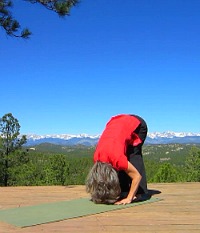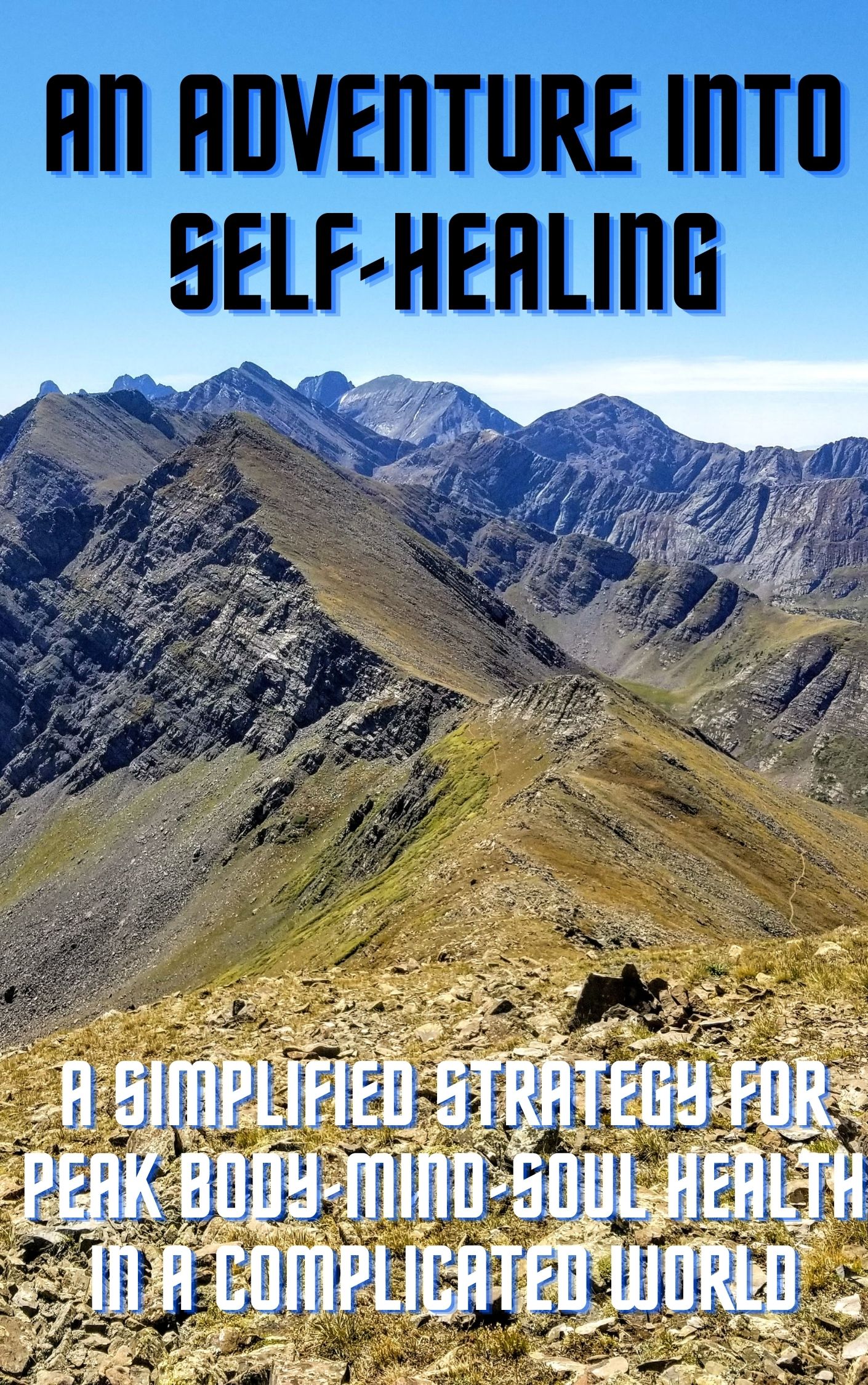Way ~ Through Your Body!
- Home
- Chronic Pain
- Sacroiliac Joint Pain
The Mystery of Sacroiliac Joint Pain
Sacroiliac joint pain is lower back pain that originates at the sacroiliac joint in the hip. The SI joint itself is often a mystery to people, let alone the causes and metaphysical reasons for the manifestation of pain in this area.
Hopefully, this article will help you clear it all up and it will no longer be a mystery to you! That is my wish, and if you follow my recommendations, you can have relief from your pain!
To center yourself to be more reflective on the role of this specific pain in your life, please read this quote:
'This horror of pain is a rather low instinct and... if I think of human beings I've known and of my own life, such as it is, I can't recall any case of pain which didn't, on the whole, enrich life.' ~Malcolm Muggeridge
It is difficult to imagine that lower back pain
of any origin is there for you to enrich your life. Yet it is true. A
message from your body, through sacroiliac joint pain, is always a
signal that something in your body-mind-soul needs fixing. Listening
to the pain is a way for you to slow down to understand the message and
implement the necessary changes for improvement.
Brief Anatomy of the Sacroiliac Joint
The sacroiliac joint is in the lower back at the level of the pelvis.
It is where the sacrum, the fused together bones at the very bottom of
the spine, meets the ilium bone of the pelvis or hip. This is not a
moving joint per se, but a joint that was designed to absorb the shock
of walking and running. We have two sacroiliac joints on each side of
the sacrum, the right and the left. The function of the SI joints is to
stabilize the hip as the two SI joints on either side of the hip work
together as a team.
Very strong ligaments hold the bones of the sacroiliac joint together. The sacrum and the ilium are covered with cartilage for the bones to articulate and move without problems. Due to the strength of the sacroiliac joint ligaments, this area is almost never dislocated.
Causes of Sacroiliac Joint Pain
Sacroiliac joint pain may also be described in the medical literature as sacroiliac dysfunction or sacroiliac joint inflammation. These are essentially different names for the same condition. It is the result of a hyper-mobile joint, or a joint that moves more than it should.
Women are remarkably designed to have the SI joint loosen during pregnancy for ease of delivery of a baby. The ligaments in the SI joint respond to the hormonal changes in the body that occur during pregnancy. While a normal response, the loosening of the joint can cause sacroiliac pain.
Aging and degenerative changes in the cartilage surrounding the SI joint also causes sacroiliac joint pain. Osteoarthritis due to aging is the most common cause. As the cartilage of the joint wears thin as a result of age, there is more movement in this looser joint that causes pain.
Inflammation that occurs at the SI joint often corresponds with general joint inflammation throughout the body. Inflammatory diseases of the joints include rheumatoid arthritis, ankylosing spondylitis and gout.
The final possible cause of sacroiliac joint pain is any condition that changes a person’s normal gait. Pregnancy is one cause, when the pregnant one waddles from the extra and unaccustomed weight of the blossoming abdomen.
Another cause is an abnormal gait that develops as a result of knee pain, ankle pain or other leg types of leg pain. An injury to one leg, or a person who has one leg that is shorter than another is also a cause for an abnormal walking pattern that leads to sacroiliac joint pain.
Often, when our body has a problem in one side, or one leg, the other side or another body part takes on the load and compensates for the injured part. This creates an even further imbalance in the body that is a set-up for more pain. The compensation may be subtle and insidious and catch us unaware when pain develops in an unexpected body part such as the SI joint.
Metaphysical causes of Sacroiliac Joint Pain
As with other types of lower back pain, sacroiliac joint pain is considered to originate in foundational problems surrounding our feeling of support or lack of support. Our pelvis and lower back are part of our core, or that, which supports our body at its center. It is where we ground ourselves in our "tribe" or that social group in which we belong or wish to belong.
This perceived support could be physical, emotional, financial or spiritual. It can originate from feelings you have regarding support from your family, your spouse or significant other, your boss, your work in general, your children, your community, your church, a special social group or whatever support from whatever source you feel is lacking in your life.
This area is about non-supportive bosses and occupations, non supporting families, money concerns, social justice concerns, economic crises, personal safety and security, and so forth.
The lower back represents your foundation in your life. Lower back pain that originates in the sacroiliac joint puts you on shaky ground, because there is not much that you would be able to do without the support from your lower spine and hips. With pain in the pelvic area, it is hard to do anything in your life and you become paralyzed.
Without grounding in our lives that binds us with others, we are lost souls. Most of us cannot live as an island. Most of us do not wish to be entirely self-supporting in all things.
Is it any wonder that a lack of support causes us pain? This pain is most often manifested in our lower backs.
However deeply is our need to be supported by others, this bond also creates conflicts. At some point in our lives, the tribe’s ideals may no longer serve us and we may wish to step out and stand on our own.
You may wish to "Stand up for yourself," by becoming your own person with your own identity. When this happens, as you fulfill your own purpose in life, tribal issues may put you in a place of conflict. The conflict manifests itself in your body-mind-soul as sacroiliac joint pain (or other foundational areas of your body). If this is the case, sometimes merely recognizing your held pattern of pain is enough to cure it.
To be healthy human beings we need to balance the needs of our tribe with the needs of ourselves. If we become stuck between the world that no longer serves us, and yet are too afraid to step into the world of our destiny, our sacroiliac joint pain may become chronic.
These foundation energies that originate in our lower spine, are of the root chakra, or 1st chakra. I have developed a chakra healing meditation for this area as well!
Does Sacroiliac Joint Pain go away?
Sacroiliac joint pain may go away on its own. Pregnancy with its waddling gait resolves with the birth of the child. Osteoarthritis of the sacroiliac joint may deteriorate to the point where the cartilage is totally gone and the bones fuse together permanently. This is actually a good thing, because unlike other joints, when the sacroiliac joint becomes immobile, the pain goes away!
Conditions that are due to inflammation and other foundational causes will need medical as well as holistic treatment to ever go away. The holistic care would involve understanding the metaphysical causes of the pain and the reason you have an inflammatory personality.
Sacroiliac joint surgery to scrape out the cartilage and make the joint immobile is an unadvised solution that is done as a last resort in extreme situations.
Women and Sacroiliac Joint Pain
Women are much more susceptible to sacroiliac joint pain than men. I believe this is due to their hormonal fluctuations in any life phase. Our emotional challenges surrounding nurturing and procreation of life continually affect our hormonal balance.
I even feel these hormonal fluctuations long after having gone through menopause. I know how I feel when my hormones fluctuate. I believe that when I am in a space where something is requiring my creative energy and I ignore it, that this is when my own sacroiliac joints start to ache. It is as if I know that I need to "give birth" to something, but I am not quite emotionally, spiritually or even physically ready yet to bring this new something into my life.
My SI joint ache can be a result of a new idea developing in me, approaching a new self-discovery, a new phase in my business or a new path in my life’s journey that I must take. Even as I write this, I feel my lower back release. I know this is my truth. If you have sacroiliac problems this may be your truth as well.
Exercises for Sacroiliac Joint Pain
The path to healing your sacroiliac joint pain is through becoming more body aware. Yoga in general is a wonderful way to become more intuitive with your body and to take the inward physical journey. The benefits of yoga are many and learning insights from your body happens only when you take the time to listen to it.
Specific yoga poses that help in focusing your attention in the sacroiliac joint are easy to learn and do. One of the best yoga poses is the Forward Fold, a very grounding pose. Stand firmly with both feet planted firmly on the ground, about hip-width apart.
Slowly roll down with your upper body, folding at the waist. Bend your knees if your hamstrings are too tight. Bend at the waist only as far as you are comfortable and free of any pain. Be sure you let your arms, head and shoulders release and just hang freely.
When you do the forward fold, the positive affirmations to say to yourself, or out loud is: "I release that which no longer serves me and I stand up for myself" and "I am grounded in all things in my life" and "I am willing to see things from a new perspective" while you do the Forward Fold. Hold the pose for a minute or two. Make sure you roll back up slowly so you don't get dizzy.
The Child's Pose and the Cobra Pose done one after the other are fabulous for Sacroiliac joint pain. One pose counter balances the other.
Focus on relaxing and releasing the lower back as you do the Child's Pose. Start out on your hands and knees on the floor, hands shoulder-width apart and knees hip-width apart. Just sit back onto your heels. You may have to widen or narrow the width of your knees to find a comfortable position.
Stay here in this pose for up to five minutes, all the while affirming, "I am lovingly supported by the God/the Universe" and "I release conflict and am free to be me."
Focus on opening and receiving new energy as you do the Cobra Pose. Start out lying on your stomach on the floor. Place your hands by your chest, with your elbows in tight, as you push up with your arms to raise your upper body. Your arms are straight and your hips and legs are still on the ground. Try not to raise your hips. Hold this pose several minutes or longer. It greatly releases the hip flexors in the front of your hips that become tight from sitting all day.
If you are unable to do the Cobra Pose, you may use the Sphinx Pose as an alternative. You only raise your body to your elbows instead of higher, but the pose is just as therapeutic for you.
While you do the Cobra Pose/Sphinx Pose, also affirm, "I am open and flexible in my hips and back" and "I am open to believe in myself" and "I receive Energy from God/the Universe.
If
you do these brief exercises I show on this page for sacroiliac joint
pain at least once a day, and say your positive affirmations, I promise
you will move your energy toward healing this issue in your life!
If you want a more in-depth healing meditation, consider my 1st Chakra Healing Meditation. If you don't know what the 1st chakra is all about, click the link to learn more. Or, if you are already versed in the body's energy system, keep scrolling to purchase my healing video!
Chakra Healing Meditation for the 1st Chakra ~ Digital Download
If you purchase this video, you realize that you are purchasing a downloadable, digital product for your device. You will not receive anything in the regular mail.
After your purchase you will receive an email from the Body Window, LLC, with a link to the download. Don't forget to look in your junk email folder if you can't find the email!
While I use PayPal, you do NOT need an account to purchase my videos. Just look for the link to pay with a credit card instead!

After your purchase, you will receive two files in the confirmation email. First, is a PDF file with instructions for the yoga movements. Second, is the actual digital video to download. The video has very little instructions within it, to keep your experience more meditative. Don't forget to download both files to receive your complete package!
Heal Your Pain
Take heart, because you can heal your pain. Reflect on this healing affirmation: ‘The wound is the place where the Light enters.’ ~ Rumi
Imagine the Light entering your wound for healing.
May your path be full of Light as you journey to healing your sacroiliac joint pain!
Related Articles You May Enjoy:
- 1st Chakra Healing Meditation
- 2nd Chakra Healing Meditation
- Chronic Pain ~ Why Physical Pain, Emotional Pain and Spiritual Pain are Inseparable
- The Mystery of Phantom Pain
- Spiritual Pain vs. Spiritual Healing
- Emotional Pain
- Neck Stretches for Releasing Neck Pain
- Lower Back Pain
- Knee Pain ~ The Importance of Flexibility
- Stepping Out Without Foot Pain
- Sciatica Pain
- Tension Myositis Syndrome ~ A New Diagnosis for Chronic Pain
Can't find what you're looking for? Search this website:
Support This Website and Its Mission
Thank you so much for considering a donation to help support this website. I appreciate your thank-you for access to so much free information. If you feel you have been blessed by this website, thank-you for your donation! I promise, that I will continue to provide you with lots of information and pay it forward to all in whatever way I can!
© Copyright 2009-2024, by Elle Bieling, BodyWindow.com
All Rights Reserved
We also hereby confirm, as stated in our Privacy Policy, that we do not sell personal information of any kind.
Protected by Copyscape Plagiarism Checker ~ Do not copy content from this page.
Information on this website is not intended for medical advice. See your health care provider for any health concerns. By using this website and/or practicing any yoga postures, foam rolling exercises or other physical movements contained herein, you are agreeing that you are in good health, cleared by your healthcare professional to participate in physical activities and you release The Body Window from any liability involved in the practice.





